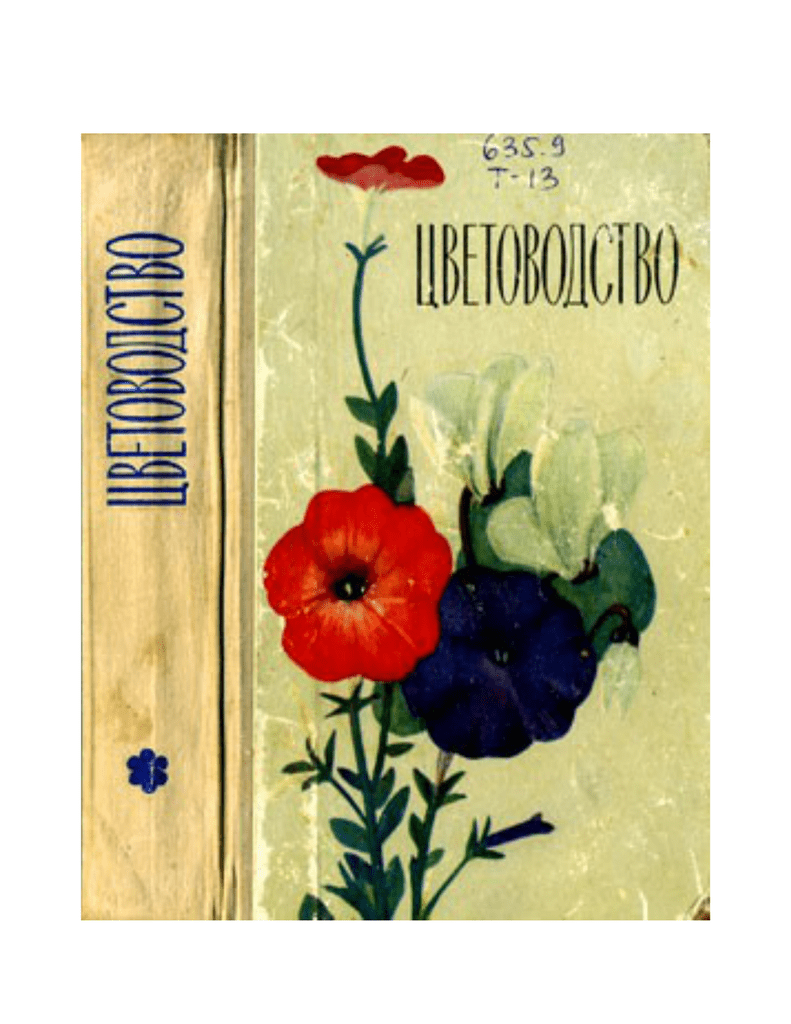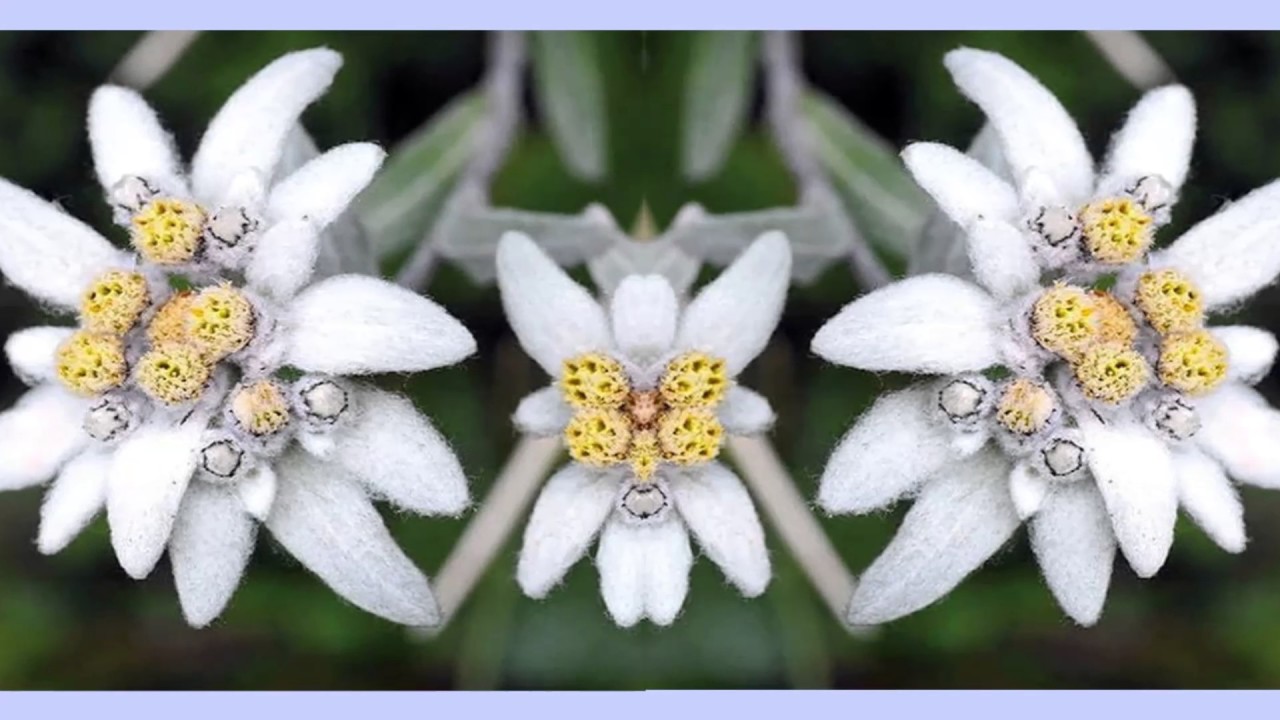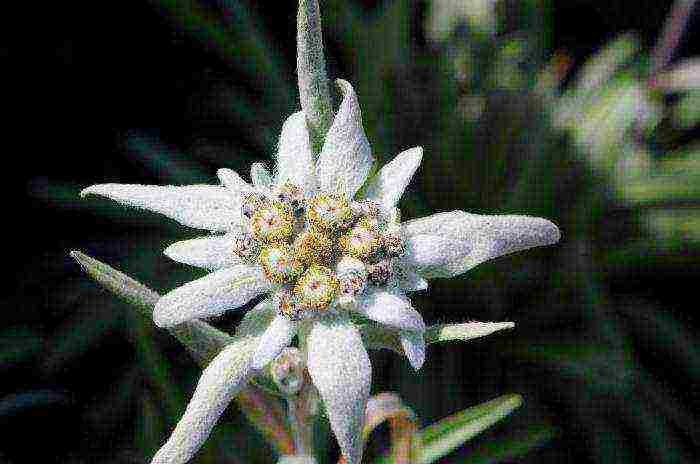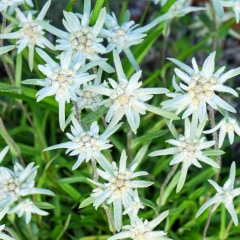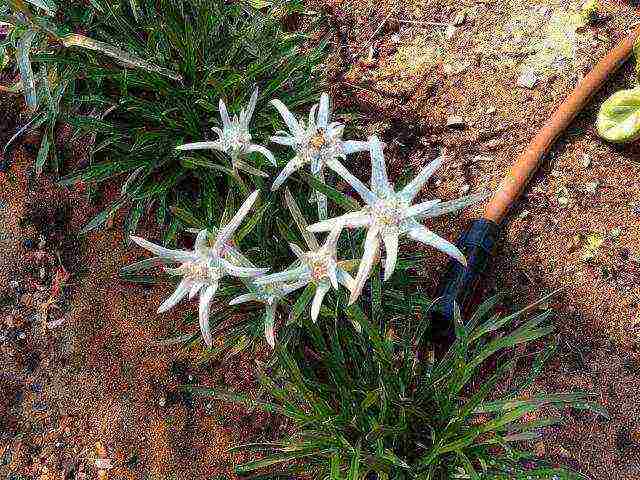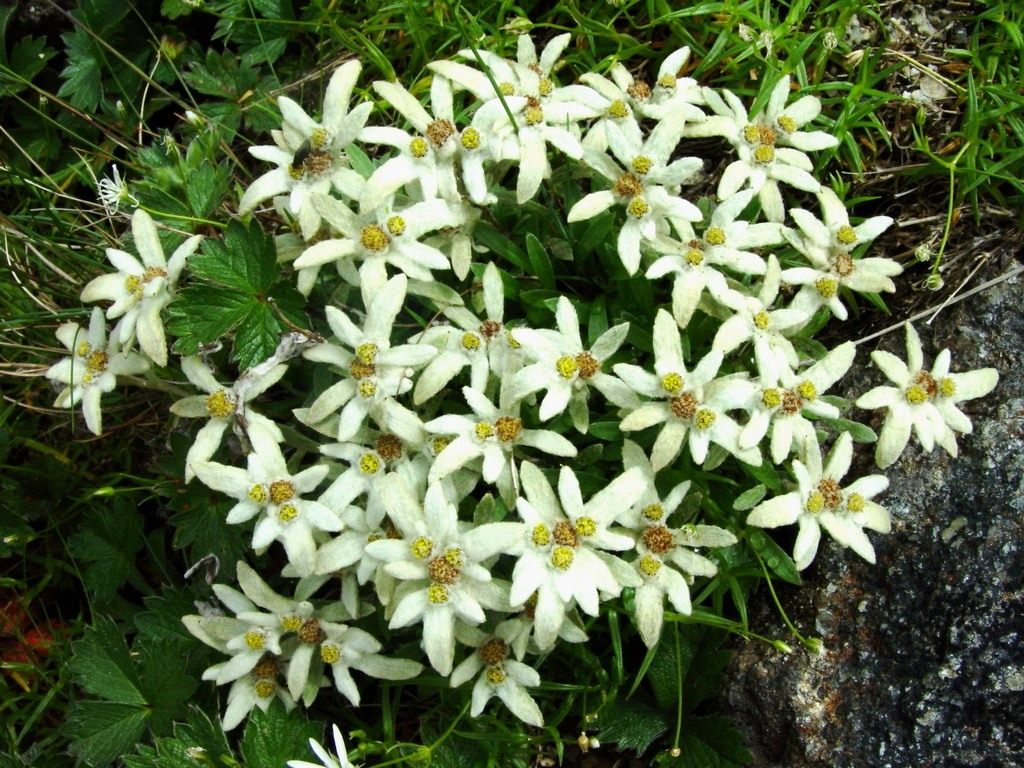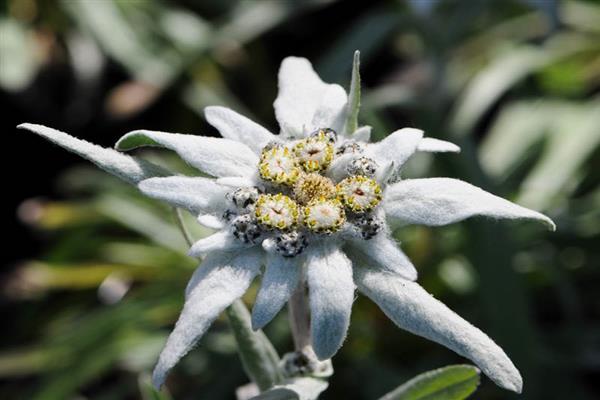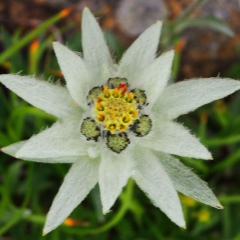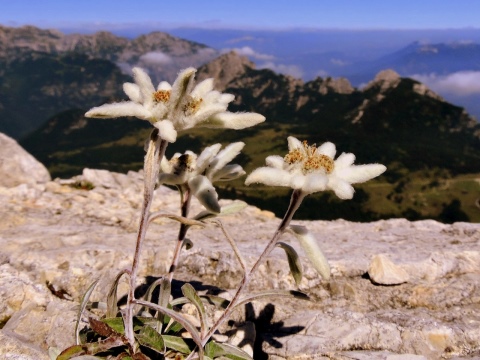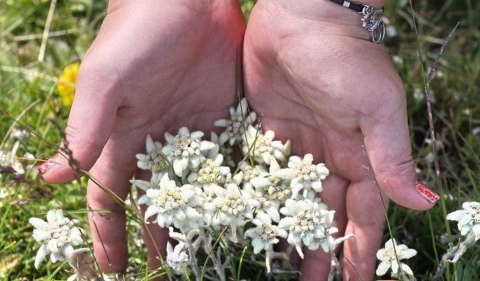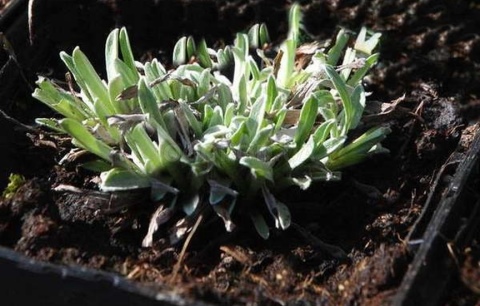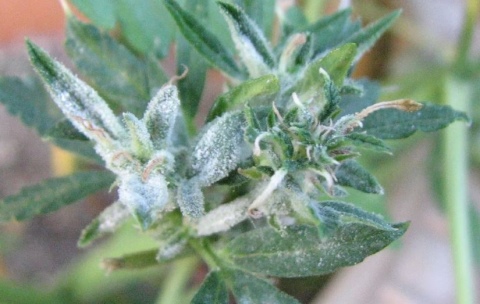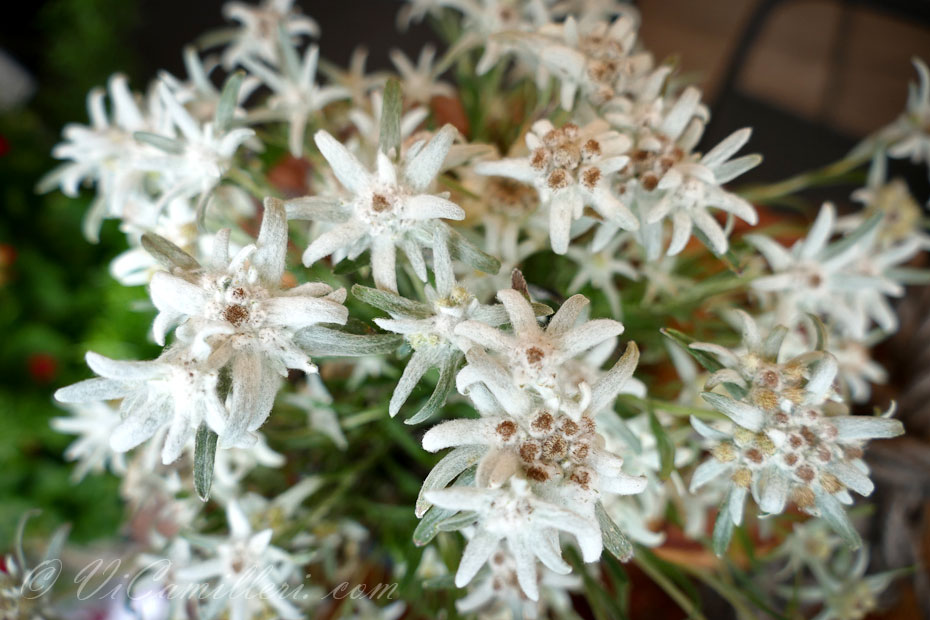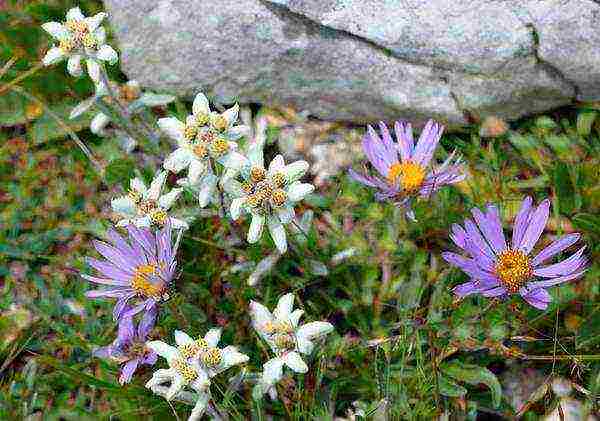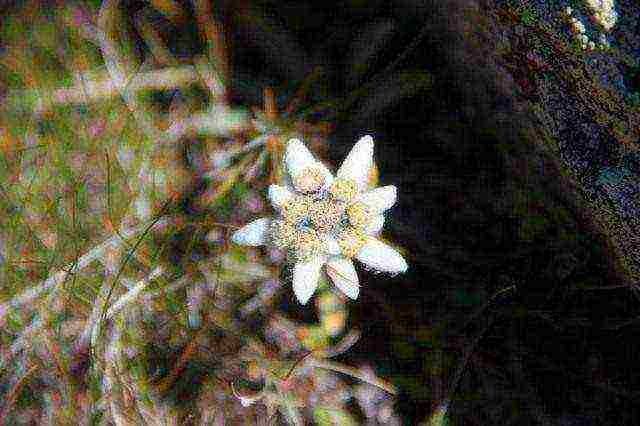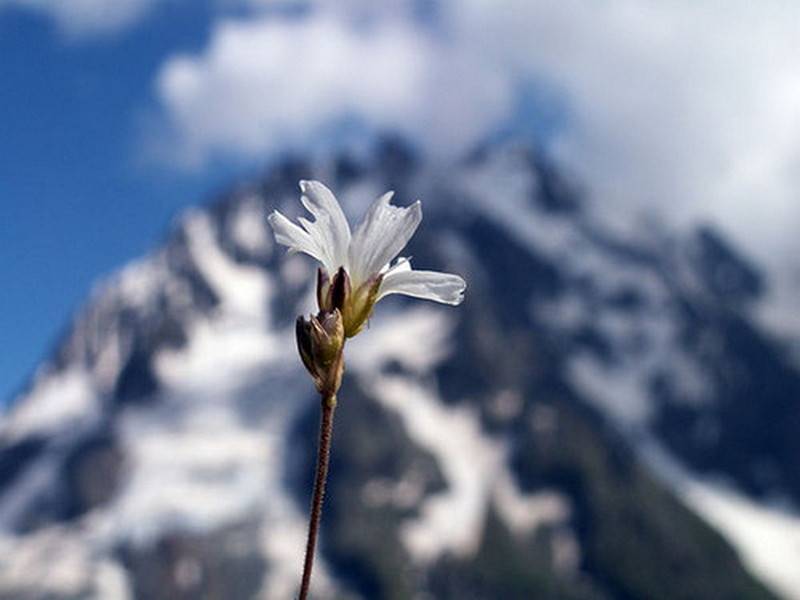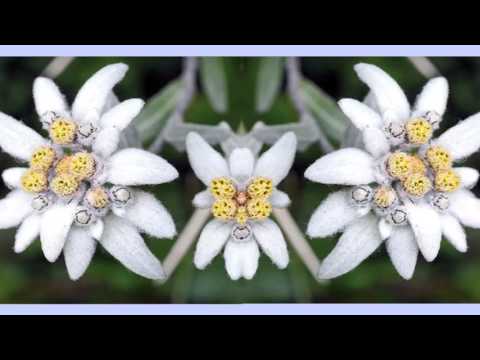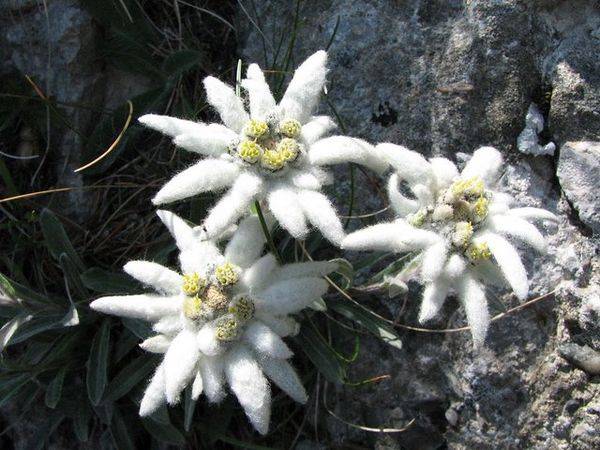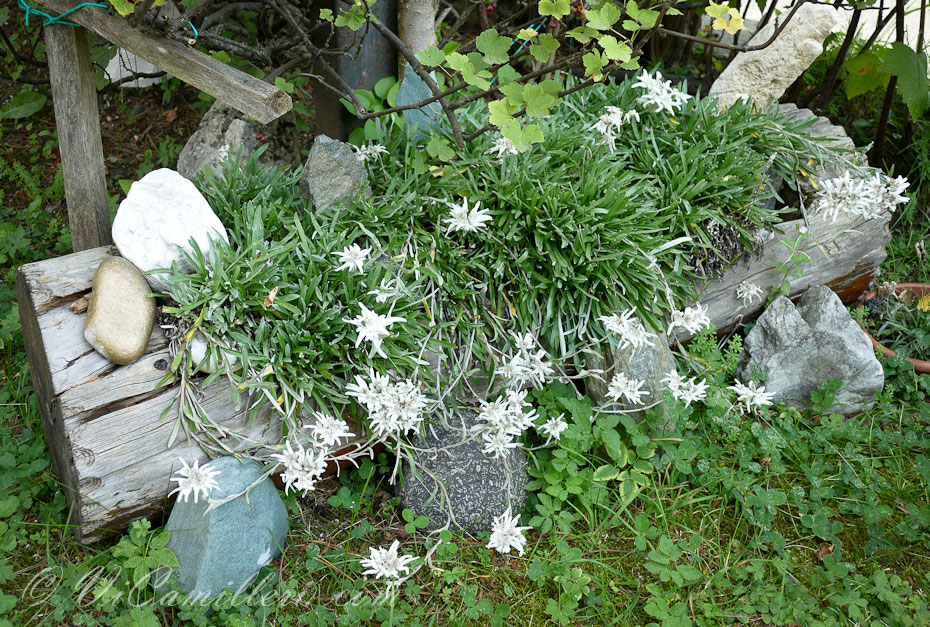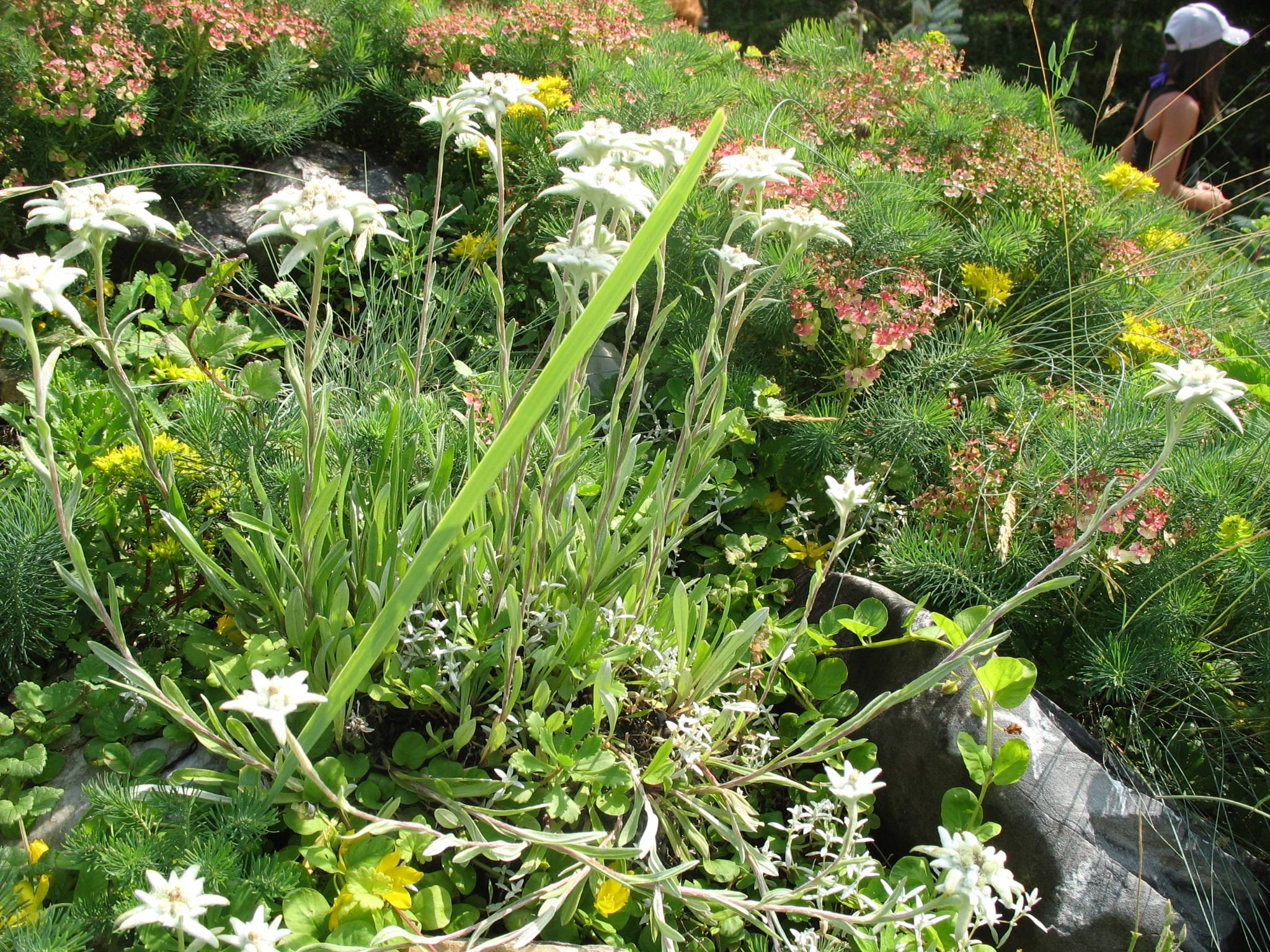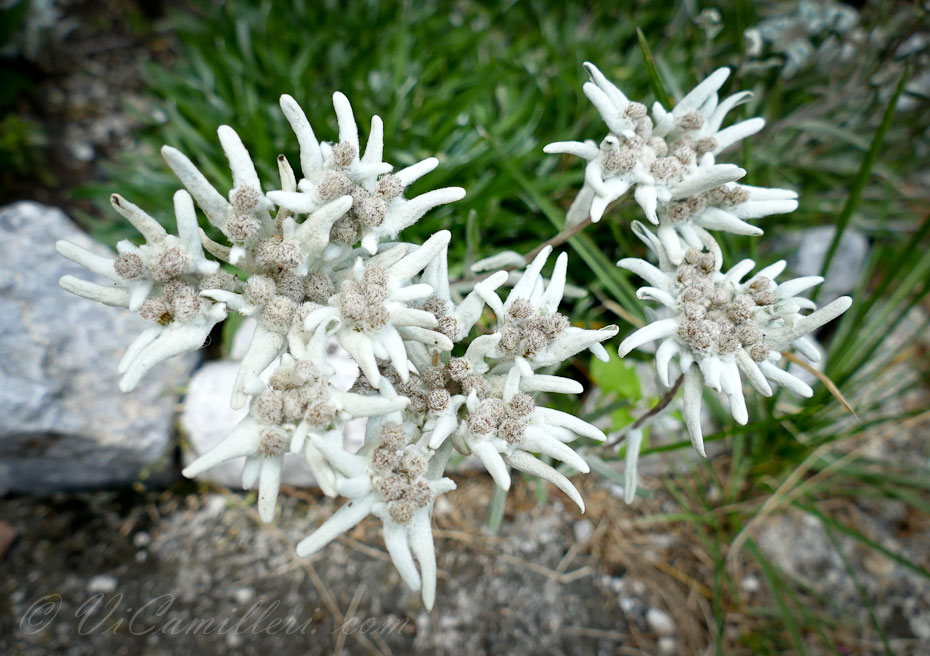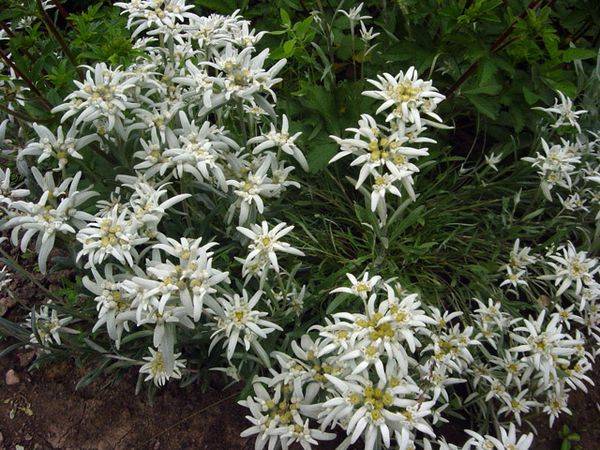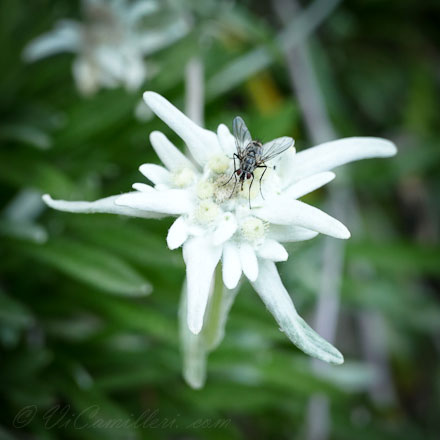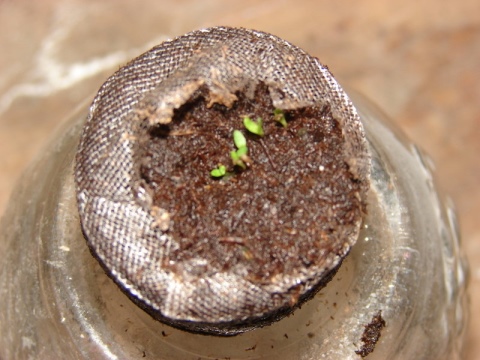Planting and caring for the plant step by step
How is edelweiss planting and caring:
Propagation by cuttings
Tip: the division of the root system of edelweiss must be carried out with extreme caution, since this plant is very sensitive to any manipulations of this kind.
Soil: rocky, sandy with good drainage.
Rooting time: May - June.
How to propagate:
Dig up the entire alpine star with a large earthy clod;
Then carefully divide the rhizomes of the overgrown plant into small fragments;
Immediately plant them in the ground in a permanent place at a distance of at least 15 cm from each other.
Seed propagation
Tip: growing from seed is the most efficient way to propagate edelweiss. Fruits (achenes) should be used harvested last year.
Soil: a universal mixture for flowers and vegetables, or a soil mixture from sand and leafy ground 1:2.
Seed stratification (hardening): about 1 month.
Sowing period: March - April.
Seedlings:
Most often, seedlings appear after a month or two;
In rare cases, after 2 weeks.
Sowing technology: practically does not differ from planting garden plants and vegetables.
Fill seedling boxes or cassette with earthy mixture;
Mix edelweiss seeds with moistened perlite or coarse river sand
And refrigerate for 3 to 4 weeks;
Then scatter the planting soil mixture evenly over the surface (without deepening into the soil);
Cover the seedlings with glass or plastic to create a greenhouse effect;
Place the cassette in a shaded place with a temperature of +13 - + 15 ° C;
Moisten and ventilate the greenhouse periodically;
As soon as shoots appear, the glass / film can be removed;
When the seedlings grow up to 2 cm, transplant them into separate pots.
Planting edelweiss in open ground
Note: The mountain flower is widely used by gardeners in the creation of alpine slides.
Priming:
The less nutritious the soil, the better for edelweiss;
The plant takes root well on limestone surfaces, between stones;
The main thing is that the soil is well-drained and does not retain moisture.
Planting period: the grown seedlings are planted in the spring, after the end of the frost. Late May - early July.
Sun or shade:
For edelweiss, an open sunny area is preferable;
In a shaded place, the plant will also quickly take root, but it will not grow much and give a beautiful bluish tint.
Distances between holes: approx. 15 cm.
Neighborhood with other plants:
Edelweiss look favorably alone or with dim colors, otherwise they can simply get lost among them;
Also not recommended plant them together with creeping plants that suppress delicate alpine flowers
Flower reproduction methods
Alpine edelweiss can be propagated by seeds, dividing a bush, cuttings. The advantage of vegetative reproduction is that its species characteristics are preserved.

Seeds
You can start sowing seeds for seedlings already at the end of February. The seeds are preliminarily kept in the refrigerator for 2-2.5 months. Then they are sorted out, rejected dry, non-viable, disinfected in a weak solution of potassium permanganate for 15-20 minutes. Planting seeds is done as follows:
- drainage from small stones or expanded clay is poured at the bottom of the planting box;
- a substrate consisting of leafy earth and sand is poured;
- shallow grooves are made into which seeds are planted, covered with soil;
- plantings are sprayed with water from a spray bottle;
- the box is covered with glass or plastic wrap.
Seedlings will appear in about 2 weeks. Every day you need to ventilate the container and wipe condensation from the covering material. In early June, young plants are planted in a permanent place. Alpine edelweiss will bloom in 2 years.
By dividing the bush
Overgrown bushes are propagated in this way.
To do this, the bush is carefully dug out, trying to injure the roots as little as possible. With a sharp knife, edelweiss is divided into 2-3 parts
Each of the divisions should have several growth points.
The procedure is carried out in spring or autumn. Bushes are planted at a distance of 15-20 centimeters from each other. The separated plants bloom next year.
Description of the marsh marigold variety, planting and care featuresRead
By cuttings
Propagated by cuttings alpine edelweiss in June. To do this, use the tops of last year's shoots. The substrate for seedlings is selected from sand, leafy earth with the addition of lime.

Cuttings are planted as follows:
- cut off parts of shoots are powdered in a preparation that stimulates root formation;
- at a distance of 10-15 centimeters, cuttings are planted in damp ground;
- cover the plantings with jars to retain moisture in them.
Seedlings are watered as needed. When they start to grow, the banks are removed. Blooming will come next season.
Important! Vegetative reproduction allows you to preserve the external features of the species
Alpine flowers: zygadenus, forget-me-not, two-seed and pyrethrum
Zigadenus (ZIGADENUS). The family of melantia (liliaceae).
The name of these alpine flowers speaks for itself - the leaves of the plant are narrow, grass-like, light green, the flowers are white, graceful, with a pronounced green center, star-shaped in a racemose inflorescence. Plant height 30-40 cm.
Growing conditions. Sunny or semi-shaded areas with loose, well-drained soils.
Reproduction. Bulbs - children, planting at the end of summer; seeds (sowing before winter).
Forget-me-not (MYOSOTIS). Borage family.
A graceful, beloved plant with bright blue flowers. Of the 50 known species, the most popular are perennials with dark green oval leaves and weak stems bearing numerous small flowers collected in a curl inflorescence. This plant of alpine meadows has long and firmly entered the culture of the middle zone, in Russia they even compose songs about it, dedicate poems.
Types and varieties:
Most often cultivated as biennial varieties of forest forget-me-nots:
Growing conditions. Shaded and semi-shaded areas with moist, loose soils.
Reproduction. Seeds (sowing in spring or summer), dividing the bush (summer). Able to weed. Planting density - 25 pcs. per 1 m2.
Two-seed (HUTCHINSIA). A family of bush (cruciferous).
Plants of mossy, limestone rocks of the mountains of Western Europe, growing at the border of the snow. These are low (10-15 cm) "pillows" with small feathery leaves.
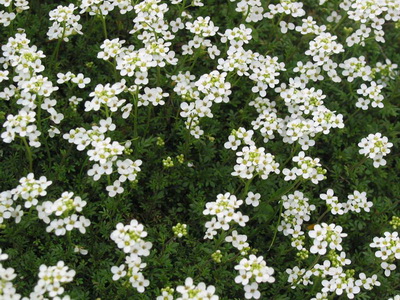
As you can see in the photo, this alpine plant has a long cluster of small white flowers.
Views:
Growing conditions. Rocky areas in partial shade, near water.
Reproduction. Seeds (sowing in spring) and dividing the bush (end of summer flowers coloring). Planting density - 16 pcs. per 1 m2.
Feverfew (PYRETHRUM). Aster family (Compositae).
Short-rhizome perennials from subalpine meadows in the mountains of southern Europe. The leaves are feathery, in a basal rosette, peduncles up to 50 cm with a single large (6-10 cm) basket - "chamomile" at the top.
Views:
Varieties:
Growing conditions. Sunny areas with rich, normally moist soils.
Reproduction. Juvenile, divide and transplant for the 3rd year.
Sow seeds in spring, seedlings bloom in the 2nd year. Planting density - 18 pcs. per 1 m2.
Growing edelweiss: characteristic features
This will not be difficult. But know, in no case do not plant next to gladioli, roses, peonies, because the flower is not visible against their background.
Alpine slides are often decorated with edelweiss. Indeed, among the stones, which are an obligatory attribute of such landscape compositions, he feels at home.
What kind of soil is suitable
The Leontopodium needs sunshine, you need to choose the right place for planting. Suitable for growing on dry, light calcareous soils. To approximate natural conditions, it is advisable to add coarse sand or crushed stone to the soil before planting.
The peculiarity of the garden “Queen of the Alps” is the negative perception of nutritious soil. From what a plant can say goodbye to its decorative effect
It tolerates poor soils and gaps between stones much better.
It is strictly forbidden to use mineral or organic fertilizers for feeding, especially the introduction of fresh manure.
And it is preferable to minimize root loosening of the soil.
It is also important to exclude stagnation of moisture in the soil. Which will help the introduction of drainage rubble and sand during planting.
Compliance with these simple recommendations will contribute to the better and faster acceptance of the plant and its further growth.
Care: transplanting, weeding, wintering
Creeping plants - will act as bad neighbors, because the growth of its roots is suppressed by the strong and persistent root system of creeping, up to the complete death of the Queen of the Alps.
Therefore, it is necessary to timely deal with weeds on the site, with planted mountain pets
Although the leontopodium is quite frost-resistant, before the arrival of cold weather, the bushes are often mulched using wood material or peat.
Mulch allows you to maintain the integrity of the snow cover over dormant plants, protecting them from freezing.
Benefit
Doctors advise people with low blood pressure to drink 3-4 cups a day. Black tea raises blood pressure and affects hypotensive patients as follows:
- dilates blood vessels and strengthens their walls thanks to the catechins contained in the drink;
- caffeine in its composition tones the body and increases human performance.
The beneficial effect of a hot and strongly brewed tea drink lasts for 3-4 hours. The use of high-quality varieties helps to reduce headaches, the disappearance of a sleepy state, and an improvement in blood pressure. But an excessive passion for tea can bring the following harm to the body:
- the appearance of constipation and other disorders of the gastrointestinal tract;
- increased intraocular pressure;
- insomnia, anxiety.
Although tea has become an integral part of modern life, it is not suitable for all people. You need to know that a strongly brewed drink removes magnesium from the body - a mineral necessary for the normal functioning of the heart and blood vessels. This tea should not be consumed by those who have the following diseases:
- Emotional instability, a tendency to neuroses. Strong tea leaves can lead to insomnia and increased pathologies of the nervous system. Only a weakly brewed drink should be consumed, 1 cup per day.
- Glaucoma and other diseases characterized by increased eye pressure. Strong tea leaves worsen the condition of such patients.
A drink made from tea leaves has a positive effect on the body both with high and low blood pressure. Black tea raises blood pressure, while green tea lowers it. The addition of various herbs and sugar to the brew reduces the effect of caffeine, so this drink can be consumed by people with high blood pressure.
You can drink black tea with hypertension, but you need to take into account the strength of the brew and the addition of other ingredients. For example, milk reduces the activity of those properties of the drink that increase the pressure level. Lemon is very useful for people suffering from this disease, as it also reduces the tonometer readings, especially if this fruit is constantly included in your diet.
When a person develops a hypertensive crisis, and the arterial level has jumped sharply, doctors even recommend bringing it down with tea, only necessarily hot and sweet. It is in this case that the drink will have a positive effect, lowering the pressure. The substances contained in the brew increase the vascular tone, due to which there is a decrease in the force with which the blood presses on the walls of the arteries.
Components:
- alkaloids;
- essential oils;
- trace elements;
- vitamin complex;
- antioxidants;
- tannins;
- amino acids.
Since ancient times, people have healed the sick with tea. All conversations and friendly meetings have never been complete without a cup of such a fragrant infusion. For hypertensive patients, there are certain ingredients in the brew that help fight high blood pressure. Vitamins, amino acids and trace elements are of particular value - they reduce the risk of atherosclerotic plaque formation in the vessels.
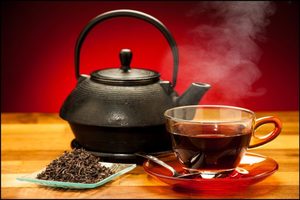
The greatest danger to general human health is represented by substances from the group of alkaloids. The caffeine content of the drink negatively affects the arterial level. Fermented tea leaves have a reduced volume of this component, and not a fermented analogue - 1% more. We must not forget that the green variety of tea leaves is also rich in caffeine, which helps to increase the tonometer readings.
This component is valuable for medicine and is often used in the preparation of medicinal products. In fact, the caffeine in tea does not pose a serious threat to human health, as it can affect the body in different ways. It all depends on the amount of drink consumed per day and interaction with other components of the brew. If you consume about 3-4 cups of this infusion per day, then the total dose of caffeine will be less than a tenth of a percent.
Based on these data, doctors conclude that there is no unequivocal answer to the question about the benefits and dangers of black tea on the course of hypertension. The main thing is to observe a reasonable amount of drink consumption and a weak brew strength. If the permissible volumes are exceeded, the pressure-increasing effect will not be long in coming.
The right choice: stones
Not every stone is suitable for the device of an alpine slide: shell rock, dolomite, tuff and other porous rocks are not suitable for the base, and, although at first glance they are very decorative, they quickly lose their appearance. You should not choose sculptures and decorations made of porous stone - for the same reasons. The optimal choice is rocks: basalt, granite, marble, limestone, sandstone. Rare types of stones with a dense, non-porous texture are also suitable.

Granite is a heavy, dense stone. Practically does not absorb moisture.
Limestone perfectly absorbs moisture; in dry periods, it gives it to the roots of plants.
Sandstone can be combined with different plants. This is the most popular option.
The shape of the stone is also very important for a rock garden - too angular or round boulders will not fit well in place, it will be difficult to group and fix them. It is better to give preference to asymmetrical stones, a natural enough shape. It is worth looking at the real mountain slopes in the photo - there are clearly visible outlines of rocky ledges, cut by rains and winds. It is better to choose stones in the same range, ideally of the same breed. The diversity and variety are good only in rare cases, and the alpine slide is quite conservative in style. An exception can be made only for pebbles, which can be quite variegated within the range.

The composition should look natural so as not to create the feeling that in front of you is a piece of nature, created by human hands.
You need to arrange stones as naturally as possible, without creating piles.The most aesthetic sides of the boulders should be turned outward, it is advisable to observe the rhythm from terrace to terrace, developing it by alternating large and medium stones, commensurate with planting pockets. Defects in stone should be masked, and industrially manufactured boulders should be replaced with natural rock fragments.
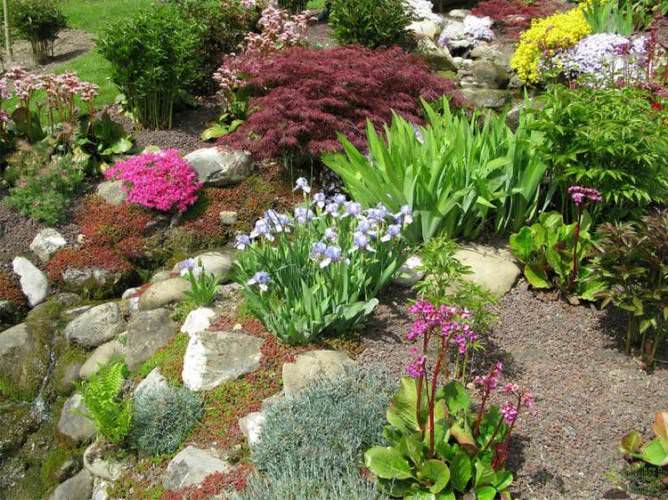
It is recommended to use various types of stones without the use of cement. This will greatly facilitate the work of creating a slide.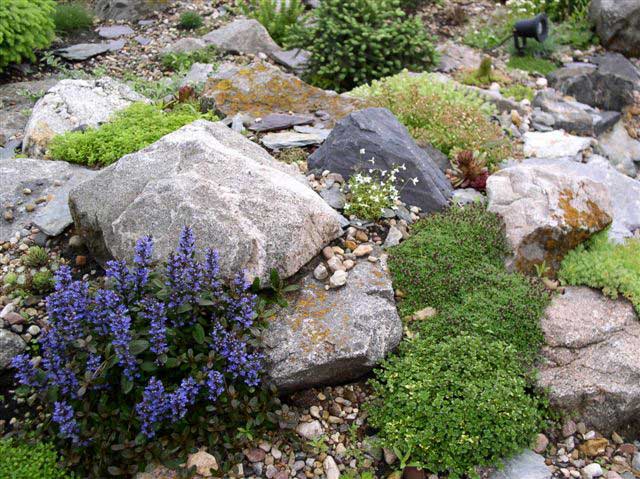
It is necessary to choose the correct number of stones. If there are not enough of them, there may be a smoothing of slopes or slipping of the soil during rain.
Features of growing in the garden
Despite its mountainous nature, the alpine star takes root well in the suburban areas of the middle lane. About landing methods and plant care we will tell you in more detail.
Growing from seeds
The most common breeding method for edelweiss. Before sowing, which is carried out in late winter - early spring, the seeds are hardened for 2-3 weeks. To do this, they are covered with foil and taken out into the cold. The subsequent algorithm consists of steps:
- the container is filled with soil mixture from garden soil, leaf soil, perlite and sand;
- the seed is evenly spread on the surface, and then lightly pressed down by hand;
- moistened with a spray bottle, cover with polyethylene on top;
- until the first shoots appear, the container with seeds is kept at a temperature not higher than +10 ° C;
- then the seedlings are opened and taken out to a warm, brightly lit place;
- when the seedlings grow up, they dive into separate cups;
- landing on the site is carried out in the second half of spring.
 Germinating seeds at home
Germinating seeds at home
Landing in open ground
In its natural environment, the leontopodium reproduces by seeds, which are scattered by the wind along the mountain slopes. So, you can sow them immediately on a flower bed. This is done after the end of return frosts, when the soil warms up well. The procedure is pretty straightforward. In a previously prepared area, small depressions are made, where the seed is placed. In this case, the interval between the seeds should be at least 8-10 cm.When the seedlings reach several centimeters, they are thinned out, leaving a distance of 20-30 cm.
Reproduction by dividing the bush
Gardeners rarely use this method, since the root system of the flower is rather fragile. However, the procedure must still be carried out every few years in order to prolong the life of the plant. It consists of several stages:
- an adult bush is carefully dug up and the rhizome is cleaned from the ground;
- with a sharp, disinfected knife, divide it into parts, leaving at each point of growth;
- the places of the cuts are treated with crushed activated or charcoal;
- the delenki are planted in a permanent place, observing an interval of 20-30 cm.
 Plant propagation by dividing the bush
Plant propagation by dividing the bush
Plant care
When choosing a place for landing, they give preference to open, brightly lit areas. With a lack of sunlight, the flower may not bloom or even die. The flower bed should not be in the lowlands, since moisture stagnation is very detrimental to edelweiss. The plant prefers poor, calcareous, sandy loam soil. Acidity levels are allowed to be neutral or slightly alkaline.
It is impossible to overmoisten the alpine star. Watering is carried out only in hot, dry periods, when natural precipitation does not fall for a long time. Irrigation is carried out under a bush using rain or soft, purified water at room temperature. Immediately after moistening, the ground around the flower is gently loosened, removing weeds.
To prolong the flowering of leontopodium, faded buds are cut from the shoots throughout the season. Also, every three years, the rejuvenation of the bushes is carried out, seating them by dividing the rhizomes.
Edelweiss may not be fertilized at all, however, some summer residents advise making mineral fertilizing once a year - in early spring.
Author's advice
A frost-resistant plant tolerates cold well, and therefore does not require additional shelter. In dry and little snowy winters, flowers can be covered with spruce branches or dry foliage.
Preparatory work: foundation
A place far from bushes and trees, light and sheltered from the wind, was finally found, it remains only to determine how dry the land is. Groundwater near the surface definitely worsens the condition of the alpine slide and reduces its durability. Special drainage helps to resolve the situation. And you will have to start creating it from the foundation pit.

The drainage pit for an alpine slide can be equal to it in area or slightly exceed its dimensions, and approximately repeat the planned outlines. To set the shape of the slide, you can drive pegs along the contour and stretch a cord or rope - you get a fairly accurate contour. Inside the outlined line, it is necessary to dig a hole with a depth of at least 80 cm - the strength of the entire structure will depend on the reliability of drainage.
The finished pit is filled with at least 30 cm with broken brick, gravel or pebbles, spilled with water for shrinkage. This is followed by 10 cm of a mixture of sand and gravel, which must not only be spilled with water, but also tamped well. On top of the drainage layers, soil is poured, extracted when digging a pit, while picking out garbage, large stones, plant roots - weeds can spoil the ensemble of the slide. The soil is also compacted, spilled with water and allowed to stand for 2-3 weeks before final shrinkage. It is ideal to do drainage before winter, so that until spring the soil will stand and settle naturally.

Having passed the preparatory stages, you can start laying stones according to the plan of the future rock garden, observing the basic rules:
- The largest stones are installed first.
- It is necessary to deepen the stone by 2/3, at least 60% - for stability
- Large stones outline the main contours of the slide, both outside and inside
- Smaller boulders are placed in the most stable position
- Decorative stones and ceramic elements are placed at the end
- Pebbles or colored sand are poured last, if they are provided for in the project
- There must be enough space between the stones for plants
- Plants can be planted after the finished rock garden has stood for 2-3 weeks - the stones will take the most stable position and become a good support for vegetation
Growing and caring for edelweiss
Location and soil requirements
Although under natural conditions edelweiss most often grows in the sunniest places, in home growing it is best to plant it in light partial shade. The main requirement for the site is that it should not be in the lowlands where moisture accumulates! The soil on the site should be poor, with a minimum content of nutrients.
Important! Edelweiss cannot be fed. Fertilizers of any kind can kill a flower
At the same time, the earth must be very good at allowing moisture to pass through, preventing stagnation of water. It is highly desirable to create conditions for edelweiss as close as possible to natural ones. Add coarse sand and small stones to the ground. It also drains the soil.
Edelweiss look equally good both in group plantings and singly. But if you want to achieve naturalness, then do not plant them in large groups. Edelweiss is not a cornflower or a chamomile, it does not grow in glades! This flower combines very well with other low-growing garden flowers, especially with those recommended for the organization of alpine slides. Exceptions are creepers (periwinkle, for example). Such plants are able to suppress the growth and development of edelweiss, up to their death.
Care
Edelweiss does not need special care. Watering is moderate, and even then, if the summer is hot and dry. Natural watering is usually sufficient. Edelweiss does not need loosening of the soil, moreover, they are harmful to it. It is imperative to break through the weeds.
Edelweiss tolerates cold quite well, but before the onset of cold weather it is still advisable to slightly cover it with mulch (peat, fallen leaves, sawdust, etc.).
Every two to three years, the edelweiss must be transplanted to another place. It is also possible within a flower garden or an alpine slide. If it grows in one place for a long time, it will quickly grow and lose its decorative effect.
Have you noticed a mistake in the text? Select it with the mouse and press Ctrl + Enter
Edelweiss is a beautiful hardy perennial flower about 30 cm high.In its natural environment, it is found in the alpine and subalpine climatic zone along the rocky slopes of the mountains, but we do not need to look for them in the mountains - edelweiss grows beautifully in the rocky, sandy well-drained soil of gardens.
They are ideal for covering the soil in mass plantings, in curbs. One contraindication for growing is the high humidity and sultry climate of your region.
Cultivation and reproduction process
So, considering individual plant species, we can conclude that any representative of this genus does not belong to a demanding or whimsical plant. Each of them requires a sufficiently drained sandy or stony soil and the presence of constant moisture.
The reproduction process is carried out by sowing seeds or dividing the root system. The best time for this is spring or autumn.
To plant in the open field, it is enough to simply plant seeds on its surface, observing the distance between the units equal to 8-10 cm.
Plants can also be grown at home
In this case, it is important to observe the correct temperature regime, not exceeding +10 degrees. Before planting, the seeds must go through a stratification process, the essence of which is to mix the seeds with a part of the moistened soil, after which this mixture should be placed in a cool place (refrigerator) for 21 days
The first sprouts will sprout within two months. Young plants are planted in a permanent place only after the end of the last frost in spring.
After a three-year period, edelweiss need to be transplanted to another place for further growth.
Under natural conditions, edelweiss are considered winter-hardy, but if we are talking about garden cultivation, then when winter comes, there is a need to mulch the plant, which will imitate the snow cover. Upon arrival of the spring heat, the mulch can be removed
It is important to remember that precipitation in the form of heavy rains can have a negative impact, so flowers need to be protected from heavy torrents. If the flowering period of some specimens is over, they should be disposed of to preserve the aesthetic appearance of the entire plant.
Description and features of edelweiss
There are many legends around the alpine star. According to one of them, a girl who lived high in the mountains fell in love with a young man from the lowlands. However, they were not allowed to meet each other, and the young maiden, approaching the edge of the cliff, shed bitter tears down. In the place where they fell, flowers of unusual beauty grew, which are still associated with love and fidelity. Also, the plant is an unspoken symbol of climbers. Already in our time, the International Union established the Order of Edelweiss, which was awarded to the best climbers.
Leontopodium (Latin Leontopodium) is a herbaceous culture from the genus Dicotyledonous, belonging to the Astrov family. Represents one - or perennial flowers growing in small bushes. Their height ranges from 10 to 35 cm, the stems are straight, covered with narrow lanceolate leaves, which form a dense basal rosette at the base. Internal side of sheet plates densely pubescent, which allows the plant to retain moisture, and the outer is painted in a silvery-bluish hue.
 Alpine star - the second name of edelweiss
Alpine star - the second name of edelweiss
Edelweiss bloom from June to July, throwing out complex star-shaped inflorescences.They consist of several tubular baskets of yellow or white color and marginal needle-like petals of a snow-white color. All petals are covered with short fluffy pile, which makes it seem that the flower is slightly crushed by snow.
Distribution and habitats
Leontopodium is an inhabitant of the Alpine and Subalpine belt. In the wild, it grows at an altitude of at least 1.8 km, inhabiting rocky mountain slopes (Alps, Himalayas, Carpathians, Tibet). Some varieties are found in Siberia, Mongolia, and sometimes even in Korea. There, culture also grows exclusively on rocky terrain.
Chemical composition and useful properties
By studying the biochemical composition of edelweiss, scientists have discovered many useful components. So, the green part of the plant contains:
- ascorbic acid;
- vitamins A and K;
- trace elements (K, Ca, Mg);
- tannin;
- antioxidants.
Herbal remedies based on leontopodium have an antibacterial effect, relieve inflammation, relieve convulsions, remove phlegm and harmful substances. Also, the plant has immunostimulating, tonic properties, helps to relieve nervous tension, relieve the effects of stress.
Edelweiss essential oil is used in cosmetology
Collection, procurement and storage of raw materials
Edelweiss is listed in the Red Book as an endangered species, and therefore folk healers use flowers grown on their plots. Harvesting is done in summer, when the leontopodium blooms. With sharp scissors, they carefully cut the stems and hang them to dry under the shade. The finished raw materials are laid out on fabric or paper bags, where they are stored for no more than 3 years.
Application in medicine
Tibetan monks were the first to use the beneficial properties of the alpine star. They treated with the plant diseases of the respiratory system, gastrointestinal tract, as well as cardiovascular problems. The chemical components that make up edelweiss help lower blood pressure, relieve joint pain, and remove stones from the bile ducts. To slow down the aging process, the flower is often used in the manufacture of anti-aging cosmetic products.
Harm and contraindications
Unlike other medicinal crops, leontopodium does not contain harmful substances and is also non-toxic. There are no strict contraindications to it. People with individual intolerance, pregnant and lactating women need to be careful.
Botanical description of Venidium
According to the botanical description, Venidium is a perennial, annual or biennial herb with pubescence on stems and leaves, 50 - 70 cm high. The root system is highly branched, lies close to the soil surface.
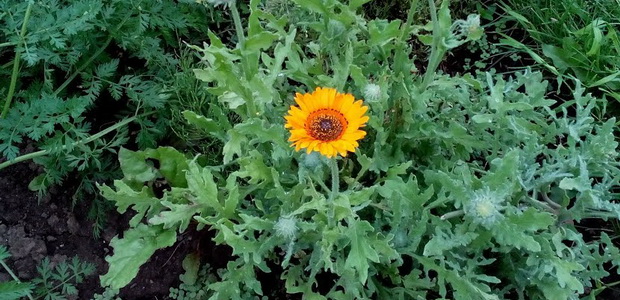
Leaves located along the entire length of the shoot, sessile, lobed or dissected, dark green in color.
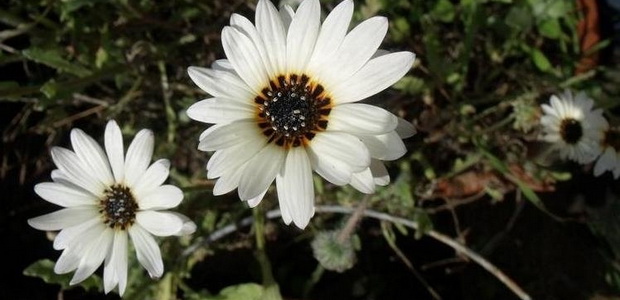
Globular flowers, diameter from 5 to 14 cm perched on long, bright orange peduncles. Petals are oval, oblong, pointed at the ends, colored with a transition from yellow to orange. In the center, the circle is brownish-red.
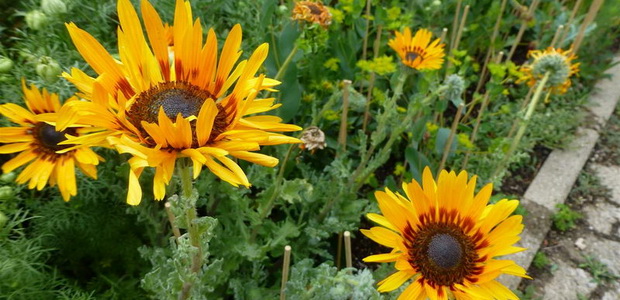
Venidium begins to bloom in June, flowering lasts until September, sometimes longer. The flowering of the plant is prolonged if the gardener timely removes the faded inflorescences. In their place, new buds appear very quickly.
Outwardly, this culture resembles a chamomile, for which the people received the name "African chamomile".
At the end of flowering, the fruit is formed - a rounded smooth winged achene. After full maturation, it bursts, after which small light seeds are scattered to the ground or carried by the wind over long distances. As a result, Venidium can be found in different parts of the garden.



